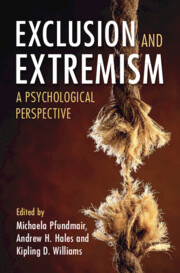Book contents
- Exclusion and Extremism
- Exclusion and Extremism
- Copyright page
- Dedication
- Contents
- Contributors
- Introduction
- Part I The Link between Exclusion and Extremism
- Part II Drivers of the Exclusion–Extremism Link
- 6 Extremism and Exclusion
- 7 Divided Groups, Polarized Identities, and Extremist Behavior
- 8 It’s the Group, Not Just the Individual
- 9 “Who Do They Think We Are?!”
- 10 The Exclusion–Extremism Link in Non-WEIRD Populations
- Part III Topics Related to the Exclusion–Extremism Link
- Index
- References
6 - Extremism and Exclusion
The Role of the Quest for Significance
from Part II - Drivers of the Exclusion–Extremism Link
Published online by Cambridge University Press: 16 May 2024
- Exclusion and Extremism
- Exclusion and Extremism
- Copyright page
- Dedication
- Contents
- Contributors
- Introduction
- Part I The Link between Exclusion and Extremism
- Part II Drivers of the Exclusion–Extremism Link
- 6 Extremism and Exclusion
- 7 Divided Groups, Polarized Identities, and Extremist Behavior
- 8 It’s the Group, Not Just the Individual
- 9 “Who Do They Think We Are?!”
- 10 The Exclusion–Extremism Link in Non-WEIRD Populations
- Part III Topics Related to the Exclusion–Extremism Link
- Index
- References
Summary
Extremism of all types arises from a motivational imbalance wherein one need outweighs all other needs. When such a process occurs, more means to achieving the focal goal, including those considered extreme, become available to the individual. Presently, we focus on the need for significance, an existential social need. When the quest for significance is dominant, an individual may be willing to make extreme sacrifices in order to achieve their goal. The quest for significance can be activated through many different means, one of which is the loss of significance through exclusion. When one perceives that they have been excluded, their motivation to regain respect is activated. When this motivation to restore significance comes to suppress one’s other needs, the individual becomes willing to engage in activities they may have previously considered socially unacceptable, including joining extreme groups and participating in violence, in order to fulfill their quest for significance.
- Type
- Chapter
- Information
- Exclusion and ExtremismA Psychological Perspective, pp. 123 - 140Publisher: Cambridge University PressPrint publication year: 2024



